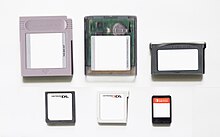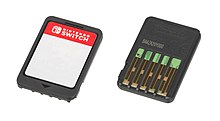How To Put In Game Card Switch
| Media type | Flash ROM |
|---|---|
| Chapters | DS/DSi: 8–512 MB 3DS/New 3DS: 128 MB–viii GB Nintendo Switch: 1–64 GB |
| Adultby |
|
| Weight | 3.5 g (0.12 oz) |
| Usage | Nintendo DS family Nintendo 3DS family Nintendo Switch family unit |
A Nintendo Game Card is a flash storage-based format used to physically distribute video games for sure Nintendo systems. The game cards resemble both smaller and thinner versions of Hudson's HuCard, the storage medium for the PC-Engine, and the Game Pak ROM cartridges used for previous portable gaming consoles released by Nintendo, such as the Game Boy and Game Male child Advance.[1] The mask ROM chips are manufactured by Macronix and have an access speed of 150 ns.[2]
Nintendo DS [edit]
Nintendo DS Game Card [edit]

Cards for the Nintendo DS ranged from 64 megabits to 4 gigabits (8–512 MB) in capacity[three] [4] The cards contain an integrated flash memory for game data and an EEPROM to salvage user data such as game progress or loftier scores. However, there are a small number of games that take no save memory such as Electroplankton.
According to an IGN weblog by Courage Entertainment, the programmer of MechAssault: Phantom War, larger (such as 128 MB) cards have a 25% slower data transfer charge per unit than the more common smaller (such as 64 MB) cards; still, the specific base rate was not mentioned.[5]
Nintendo DSi Game Card [edit]
In 2008, the Nintendo DSi was launched. The console offered various hardware improvements and additional functions over previous Nintendo DS iterations, such equally the inclusion of cameras. While many Nintendo DS titles released later on included features that enhanced gameplay when played on the Nintendo DSi console, most of these games retained compatibility with the original DS iterations. Still, a select few retail game titles were released that worked exclusively for the Nintendo DSi consoles for reasons such as requiring camera functions, and these titles have game cards with white-colored casings (all DSi-exclusive games are region locked). Examples of such game cards include Moving picture Perfect Hair Salon. While these white game cards can be physically inserted into original Nintendo DS consoles, their software did not function due to the missing hardware features and will display an fault message. These DSi-exclusive game cards are fully uniform with the Nintendo 3DS family.
Prior to the release of the Nintendo DSi, Nintendo encouraged developers to release DSi-sectional games as DSiWare downloadables instead of retail game cards that would not function on older Nintendo DS consoles.[6]
Infrared back up [edit]

Pokémon Blackness Version cartridge.
Despite all iterations of the Nintendo DS line lacking native infrared back up, certain titles made utilise of this blazon of communication role using game cards with their own infrared transceivers. These game cards are generally glossier and darker than mutual Nintendo DS game cards, and reveal their translucency when exposed to light. Examples of such game cards include Personal Trainer: Walking and Agile Health With Carol Vorderman, which connect to the included pedometers, Pokémon HeartGold and SoulSilver, which connect to the included Pokéwalker accessory,[7] and Pokémon Black and White and Pokémon Black ii and White 2, which connect DS systems facing each other.[8] [9]
Although all iterations of the Nintendo 3DS family support native infrared functions, Nintendo DS games withal use the infrared-enabled game cards themselves when played on a 3DS system, reserving the native infrared for Nintendo 3DS-specific software.[ commendation needed ]
Nintendo 3DS [edit]
Game cards for the Nintendo 3DS are from 1 to 8 gigabytes in size,[10] with 2 GB of game data at launch.[eleven] They look very like to DS Game Cards, just are incompatible and have a small tab on one side to foreclose them from existence inserted into a DS, DS lite, or a DSi.[12]
Nintendo Switch [edit]

The Nintendo Switch uses wink rom engineering similar to SD cards that are officially called game cards. This iteration is smaller and has a larger storage chapters than its previous versions.[thirteen] Despite its similarities, the Switch is non compatible with DS and 3DS cards.[xiv] The game cards used in the Switch are non-writable and save data is stored in the console's internal retentivity, unlike the DS and 3DS'due south game cards, which are writable and are able to shop relieve information.[15]
Because of their small size, the Game Cards are coated with denatonium benzoate, a not-toxic bitterant, as a safety precaution against accidental consumption by young children.[16] Videos of users intentionally tasting the cartridges and reacting with cloy at the taste became a meme prior to the console's launch, which originated from Jeff Gerstmann's actions on a Giant Flop webcast.[17] [18]
The cards come in a variety of capacities: 1 GB, 2 GB, 4 GB, 8 GB, xvi GB and 32 GB.[19] 64 GB cartridges were planned to be introduced in the second half of 2018, but due to unspecified circumstances, Nintendo originally delayed the launch of this variant to 2019,[20] and so delayed again to 2020. As planned the 64 GB cartridges released in 2020 and are made using XtraROM engineering from Macronix.[21] [ needs update ]
References [edit]
- ^ Vuijk, Rafael (eleven October 2006). "First Nintendo DS cartridge data". Dark Fader (Rafael Vuijk). Retrieved 10 February 2010.
- ^ "Nintendo: NDS Disassembly". GainGame's Blog. Archived from the original on 25 February 2010. Retrieved 10 February 2010.
- ^ Ni no Kuni was the starting time DS game to use a 4-gigabit menu "GoNintendo: Level five'south press conference - massive info roundup (Fantasy Life announced, Ninokuni'south massive DS cart, and much more!)". Archived from the original on eleven July 2011. Retrieved 13 April 2010.
- ^ Adam Riley (15 July 2007). "E3 2007 News - Archaic Sealed Estrus (Nintendo DS) RPG Details". Cubed³. Retrieved 4 November 2007.
- ^ Sara Guinness (16 June 2006). "MechAssault DS Developer Diary". IGN. Archived from the original on 25 December 2016. Retrieved 12 June 2020.
- ^ Craig Harris (25 March 2009). "GDC 09: DSi Hybrid, Sectional Carts Soon". IGN. Fox Interactive Media. Archived from the original on 27 March 2009. Retrieved 23 June 2010.
- ^ "Pokewalker Operations Transmission" (PDF). Nintendo. Archived (PDF) from the original on thirteen March 2021. Retrieved 7 July 2021.
The Pokéwalker accessory is a pedometer specially designed for use with a Pokémon HeartGold or SoulSilver Version Game Card, by using infrared communication between the Game Card and the Pokéwalker.
- ^ "Pokemon Black 2 Instruction Booklet" (PDF). Nintendo. Archived (PDF) from the original on 17 June 2021. Retrieved seven July 2021.
You can connect to nearby Nintendo DS systems using Infrared Connection.
- ^ "Pokemon Black Instruction Booklet" (PDF). Nintendo. Archived (PDF) from the original on 30 April 2021. Retrieved vii July 2021.
You can connect to nearby Nintendo DS systems using Infrared Connection.
- ^ Yeung, Karlie (17 Dec 2010). "3DS Cartridges Could Shop Up to 8GB". Nintendo Globe Report. Retrieved 31 January 2012.
The memory size for Nintendo 3DS cartridges will range from one to 8 gigabytes, reports major Taiwanese newspaper Cathay Times.
- ^ Pereira, Chris (21 June 2010). "A Look at the New Nintendo 3DS Game Cards". 1UP.com. UGO Entertainment. Archived from the original on 30 May 2012. Retrieved 20 November 2016.
- ^ "Nintendo 3DS Game Cards Look Like This". Siliconera. eighteen June 2010. Retrieved 7 November 2012.
- ^ "Nintendo Switch will use cartridges". Polygon. Voice Media. Retrieved xx October 2016.
- ^ Arnold, Cory (21 October 2016). "Nintendo Switch non compatible with physical 3DS or Wii U games". Destructoid . Retrieved 21 October 2016.
- ^ Schreier, Jason (20 January 2017). "Nintendo Answers (And Avoids) Our Switch Questions". Kotaku . Retrieved 20 January 2017. "Nintendo Switch game cards are non-writable; game save data is stored in internal NAND retentiveness."
- ^ Dornbush, Johnathon (2 March 2017). "Nintendo Switch Game Cards Taste Terrible". IGN . Retrieved 3 March 2017.
- ^ "Nintendo Switch cartridges 'taste so bad'". BBC News . Retrieved seven March 2017.
- ^ "New trend: Putting disgusting Nintendo Switch cartridges in your mouth". The Daily Dot . Retrieved 7 March 2017.
- ^ Yin-Poole, Wesley (13 March 2017). "Why Nintendo Switch games are ending up more expensive". Retrieved 13 March 2017.
- ^ Mochizuki, Takashi (27 December 2017). "Nintendo Delays Rollout of 64-Gigabyte Switch Game Cards Until 2019". The Wall Street Journal . Retrieved 27 December 2017.
- ^ Rahming, A.K. (24 Dec 2019). "Switch game cards potentially getting a 64GB variant". Nintendo Enthusiast . Retrieved 25 December 2019.
How To Put In Game Card Switch,
Source: https://en.wikipedia.org/wiki/Nintendo_Game_Card
Posted by: caosuster.blogspot.com


0 Response to "How To Put In Game Card Switch"
Post a Comment